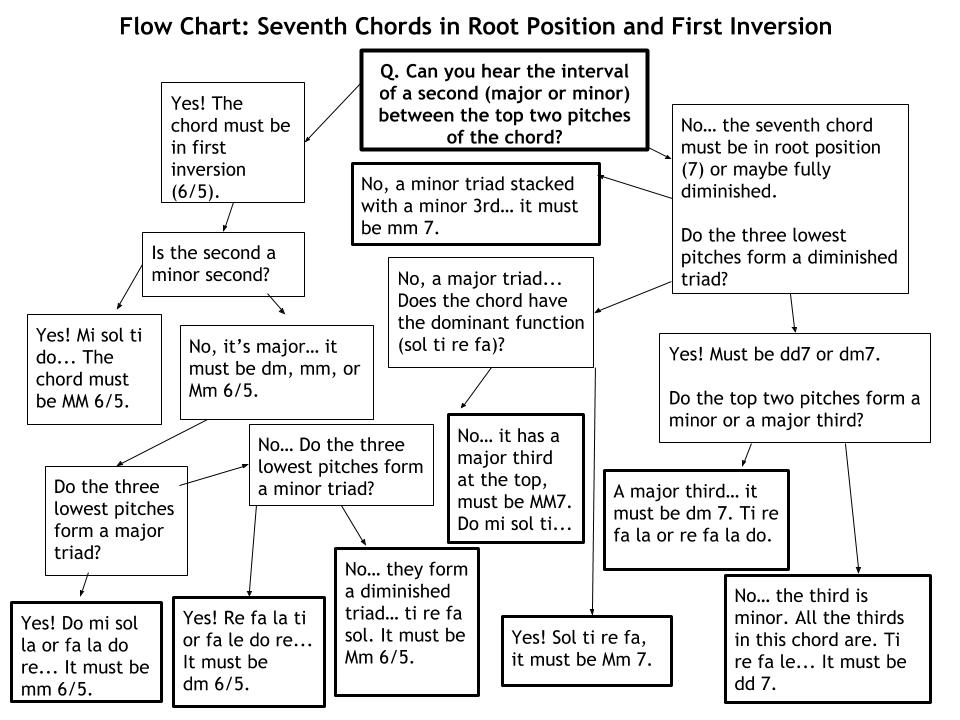Integrated Aural Skills 2019-20
Ear Training - How Seventh Chords Work in Root Position and First Inversion
Inverting Seventh Chords
Just like triads, seventh chords may be inverted.
When seventh chords appear in root position, we identify them with the figured bass “7” as an abbreviation of “1-3-5-7.” When they appear in first inversion, we identify them with the figured bass “6/5” as an abbreviation of “1-3-5-6.” Please study, sing, and play the following 7 and 6/5 chords as they appear, side by side, in the keys of D minor and D major (as applicable), and memorize the chart below, which explains how to identify the chords as they appear in first inversion.

Memorize the following table of intervals, solfege, and salient features of the five types of 7th chords in first inversion
| Chord | dd 6/5 | dm 6/5 | mm 6/5 | Mm 6/5 | MM 6/5 |
|---|---|---|---|---|---|
| Triad + Interval | diminished triad + augmented 2nd | minor triad + major 2nd | major triad + major 2nd | diminished triad + major 2nd | minor triad + minor 2nd |
| Common Harmonic Function | vii0 6/5 in minor keys | iiø 6/5 in minor keys OR viiø 6/5 in major keys | ii 6/5 OR vi 6/5 in major keys | V7 in major AND minor keys | rare in classical music, but can be I 6/5 in major keys in jazz |
| Solfege | re fa le ti | fa le do re OR re fa la ti | fa la do re OR do mi sol la | ti re fa sol | mi sol ti do |
Step-by-step method for identifying seventh chords in root position and first inversion
- Find the “color” of the chord in a way that is meaningful to you, i.e. Mm=dominant function, MM=jazz, dd=suspenseful, etc.
- Listen intervallically to ascertain whether the chord is in root position or first inversion. The big question: can you hear the interval of a second between the top two pitches of the chord? If yes, the chord is in first inversion.
- Check your hypothesis: does the evidence support it? (i.e. all intervallic relations; implied function and context.)
Cheat sheet: memorize these quick methods for recognition
- Is there a minor 2nd anywhere? If so, the chord can only be MM 6/5.
- Do the lowest three pitches form a major triad? If so, the chord can only be mm 6/5.
- Do the lowest three pitches form a diminished triad? If so, there are only two possibilities: dd 7 or Mm 6/5. The dd 7 chord will always sound as if it is in root position because of its symmetricality. Mm 6/5, of course, has a major 2nd between its two highest pitches, so listen carefully for those.
- Can you hear a major 2nd between to top two pitches? If so, there are only three possibilities: dm 6/5, mm 6/5, or Mm 6/5.
Extra Study Materials
In class, we will go over different methods for quickly identifying them in quizzes and exams, where we must hear them outside of their melodic and harmonic contexts in diatonic music.
One way to study these concepts effectively is to build a flow chart where you can go logically through steps that will help you find the right answer - and, crucially, eliminate wrong answers. The flow chart below is designed to help with identifying seventh chords in root position (7) and first inversion (6/5). This is just one way of building a flow chart. Try building your own, starting with a different initial question!
